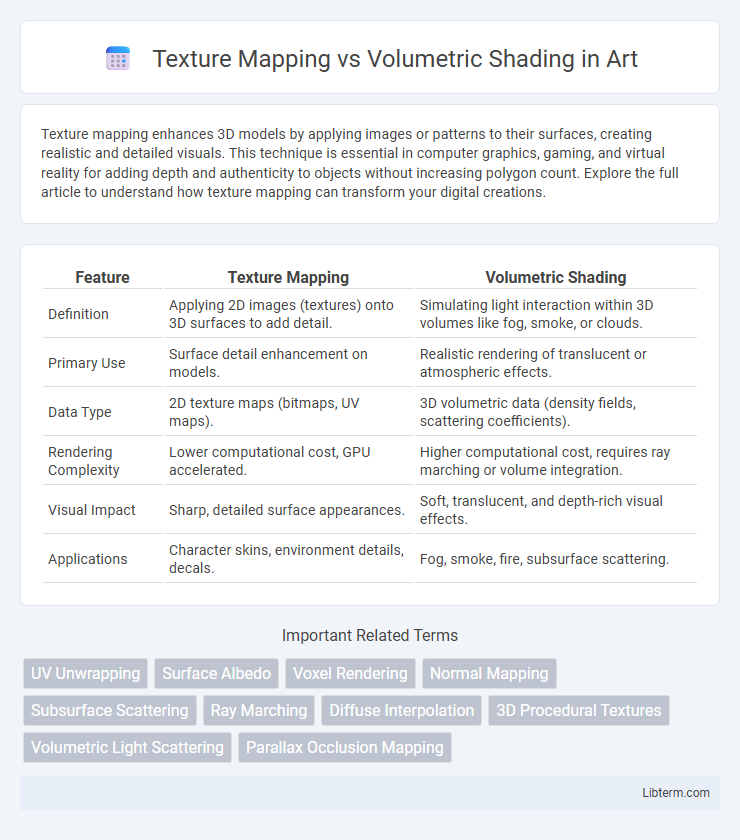Texture mapping enhances 3D models by applying images or patterns to their surfaces, creating realistic and detailed visuals. This technique is essential in computer graphics, gaming, and virtual reality for adding depth and authenticity to objects without increasing polygon count. Explore the full article to understand how texture mapping can transform your digital creations.
Table of Comparison
| Feature | Texture Mapping | Volumetric Shading |
|---|---|---|
| Definition | Applying 2D images (textures) onto 3D surfaces to add detail. | Simulating light interaction within 3D volumes like fog, smoke, or clouds. |
| Primary Use | Surface detail enhancement on models. | Realistic rendering of translucent or atmospheric effects. |
| Data Type | 2D texture maps (bitmaps, UV maps). | 3D volumetric data (density fields, scattering coefficients). |
| Rendering Complexity | Lower computational cost, GPU accelerated. | Higher computational cost, requires ray marching or volume integration. |
| Visual Impact | Sharp, detailed surface appearances. | Soft, translucent, and depth-rich visual effects. |
| Applications | Character skins, environment details, decals. | Fog, smoke, fire, subsurface scattering. |
Introduction to Texture Mapping and Volumetric Shading
Texture mapping applies 2D images onto 3D models, enhancing surface detail and realism by simulating materials like wood, metal, or fabric. Volumetric shading deals with light interaction within 3D volumes, simulating effects such as fog, smoke, and translucent materials, providing depth and atmospheric realism. Both techniques are fundamental in computer graphics for achieving visually rich and immersive environments.
Core Principles of Texture Mapping
Texture mapping involves applying 2D images onto 3D surfaces to create detailed appearances without increasing geometric complexity. It uses UV coordinates to map each pixel on the texture to a point on the model, enhancing realism through diffuse, specular, and normal maps. Unlike volumetric shading, which calculates light interaction within a volume, texture mapping focuses on surface detail by embedding image data directly onto polygonal meshes.
Fundamentals of Volumetric Shading
Volumetric shading simulates light interaction within a three-dimensional medium, accounting for absorption, scattering, and emission of light, unlike texture mapping which applies 2D images onto surfaces. It models complex phenomena such as fog, smoke, and subsurface scattering by calculating light diffusion through volumes, enabling realistic rendering of semi-transparent materials. This technique relies on volumetric data representation and ray-marching algorithms to capture cumulative light effects within the volume.
Key Differences Between Texture Mapping and Volumetric Shading
Texture mapping involves applying 2D images onto the surfaces of 3D models to add detailed color, patterns, and textures, enhancing visual realism while remaining surface-bound. Volumetric shading simulates light interaction within a 3D volume, such as fog, smoke, or clouds, capturing effects like light absorption, scattering, and emission throughout the volume. The key difference lies in texture mapping's focus on surface detail versus volumetric shading's emphasis on rendering translucent or semi-transparent materials within a three-dimensional space.
Performance Considerations in Rendering
Texture mapping generally offers faster rendering performance due to its use of 2D images mapped onto 3D surfaces, requiring less computational power compared to volumetric shading, which involves complex calculations of light scattering within 3D volumes. Volumetric shading significantly impacts rendering times as it simulates light interaction within media like fog or smoke, demanding advanced algorithms and higher memory usage. Optimization techniques such as level of detail (LOD) and hardware acceleration are critical for managing performance in scenes leveraging volumetric shading.
Visual Realism: Surface Detail vs Depth
Texture mapping enhances visual realism by applying detailed 2D images onto 3D surfaces, creating intricate patterns and material appearances like wood grain or fabric weaves. Volumetric shading contributes depth and volume to scenes by simulating light interaction within semi-transparent materials such as fog, smoke, or translucent skin, producing a more immersive sense of spatial presence. Combining detailed surface texture mapping with volumetric light scattering achieves richer visual realism by integrating fine surface detail with atmospheric depth cues.
Common Applications in 3D Graphics
Texture mapping is widely used in video games and virtual reality to apply detailed surface images onto 3D models, enhancing realism by simulating materials such as wood, fabric, and metal. Volumetric shading excels in visual effects and medical imaging by rendering light interactions within translucent or semi-transparent materials like fog, smoke, and human tissue. Both techniques are fundamental in CGI for movies, where texture mapping defines surface detail while volumetric shading creates atmospheric depth and realistic light scattering.
Tools and Technologies Supporting Each Method
Texture mapping relies heavily on tools like Adobe Substance Painter, Blender, and Unity, which streamline the application of 2D images onto 3D models, enhancing surface details and realism. Volumetric shading utilizes advanced rendering engines such as NVIDIA's OptiX, Houdini, and Unreal Engine's volumetric fog systems to simulate light interaction within three-dimensional volumes, crucial for effects like smoke, fire, and clouds. Both methods benefit from GPU acceleration and shader programming languages like GLSL and HLSL to achieve real-time performance and high-quality visuals.
Limitations and Challenges
Texture mapping often faces limitations in detail resolution and distortion when applied to complex surfaces, leading to visible seams and stretching artifacts. Volumetric shading challenges include high computational costs and difficulties in accurately representing translucent or volumetric materials within real-time rendering environments. Both techniques struggle with balancing performance and visual fidelity, especially in dynamic lighting scenarios or intricate 3D models.
Future Trends in Computer Graphics Shading
Future trends in computer graphics shading emphasize increased realism through hybrid approaches combining texture mapping and volumetric shading, leveraging machine learning algorithms for enhanced detail and efficiency. Real-time ray tracing advancements enable volumetric effects like fog and smoke to integrate seamlessly with high-resolution texture maps, improving immersion in virtual environments. Hardware acceleration and AI-driven optimization are set to drive the next generation of shading techniques, enabling richer, dynamic scenes with complex light interactions and material properties.
Texture Mapping Infographic

 libterm.com
libterm.com